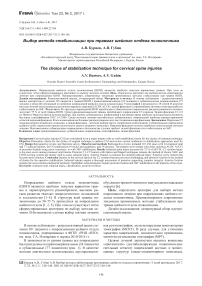Выбор метода стабилизации при травмах шейного отдела позвоночника
Автор: Бурцев Александр Владимирович, Губин Александр Вадимович
Журнал: Гений ортопедии @geniy-ortopedii
Рубрика: Оригинальные статьи
Статья в выпуске: 2, 2017 года.
Бесплатный доступ
Актуальность. Повреждения шейного отдела позвоночника (ШОП) являются наиболее тяжелым вариантами травмы. При этом не существует четко сформулированных критериев по выбору методов лечения. Цель. Определить критерии для выбора метода оперативного лечения при повреждениях ШОП. Проанализировать современные тенденции применяемых методик стабилизации при травме ШОП. Дизайн исследования. Ретроспективный анализ, литературный обзор. Материалы и методы. В основе публикации - ретроспективный анализ диагностики и лечения 101 пациента с травмой ШОП с краниоцервикальными (24 человека) и субаксиальными повреждениями (77 человек) и обзор 48 публикаций по проблеме повреждений шейного отдела позвоночника: 9 монографий и руководств и 39 статей. В качестве методов лечения использовались различные варианты передней (ACDF, ACCF), задней фиксации (с применением винтовых конструкций) или стабилизации на 360°. Результаты. В структуре повреждений ШОП преобладают субаксиальные повреждения, распространенность которых достигает 75 % от всей травмы ШОП. Среди краниоцервикальной травмы преобладают повреждения С2 позвонка. Задняя фиксация C1-C2 по Harms и Magerl остается методом выбора. Для оценки субаксиальных повреждений в настоящее время наиболее используемыми являются балльные классификации SLIC и CSISS. Среди методик лечения нестабильных субаксиальных повреждений наиболее распространенной остается передняя фиксация. В последнее время все большее распространение получает задняя винтовая фиксация. Заключение. Переломы С2 позвонка являются наиболее сложными, а задняя фиксация - методом выбора при их оперативной стабилизации. Субаксиальные повреждения требуют особо тщательной оценки целостности заднего опорного комплекса. Передняя фиксация остается наиболее используемым методом лечения. Многоколонные субаксиальные повреждения в большинстве случаев требуют задней фиксации или стабилизации на 360°.
Краниоцервикальные, субаксиальные повреждения, классификации, задняя фиксация
Короткий адрес: https://sciup.org/142121953
IDR: 142121953 | УДК: 616.711.1-001.5-089.227.84 | DOI: 10.18019/1028-4427-2017-23-2-140-146
Текст научной статьи Выбор метода стабилизации при травмах шейного отдела позвоночника
Background Cervical spine injuries (CSI) are considered to be a major trauma with no well-established criteria for the choice of treatment technique. Objective Determine criteria for the choice of surgical technique to address CSI and review current tendencies in stabilization approaches used for CSI. Design Retrospective review and literature survey. Material and methods Retrospective review included 101 CSI cases with 24 craniocervical and 77 subaxial injuries, 48 CSI publications (9 books and guidelines, and 39 articles). The patients were treated with either anterior (ACDF, ACCF) or posterior fixation using screw constructs, or with 360° stabilization. Results Subaxial spine injury accounts for 75 % of all CSI. C2 vertebra injury is the most severe among craniocervical trauma. Posterior C1–C2 fixation with Harms and Magerl techniques remains the method of choice. SLIC and CSISS scoring systems are mostly used to assess subaxial injury. Anterior fixation is common for unstable subaxial injury. Posterior screw fixation has become more common. Conclusion Injuries to the cervical spine at the С2 vertebra fractures are most challenging, and posterior fixation is the method of choice for the operative stabilization. Subaxial injuries require a thorough assessment of posterior supporting complex integrity. Anterior fixation remains the most common method of treatment. Multipillar subaxial injuries require posterior fixation and 360° stabilization in the majority of the cases. Keywords : craniocervical, subaxial injury, classification, posterior fixation
АКТУАЛЬНОСТЬ
Повреждения шейного отдела позвоночника (ШОП) являются наиболее тяжелым вариантом травмы и характеризуются разнообразием, высоким риском развития тяжелых неврологических осложнений и летальностью [1–4]. В структуре всей травмы позвоночника до 50–75 % приходится на повреждения шейного отдела [1, 2, 5]. При этом не существует четко сформулированных критериев по выбору методов лечения. В большинстве случаев выбор тактики лечения обусловлен предпочтениями и мануальными навыками хирурга [6].
Цель : определить критерии для выбора метода оперативного лечения при повреждениях шейного отделам позвоночника. Проанализировать современные тенденции применяемых методик стабилизации при травме шейного отдела позвоночника.
Дизайн исследования: литературный обзор и ретроспективный анализ.
МАТЕРИАЛЫ И МЕТОДЫ
В основе публикации – ретроспективный анализ лечения 101 пациента с повреждениями шейного отдела позвоночника, оперированных в ФГБУ «РНЦ «ВТО» им. акад. Г.А. Илизарова» в период 2010-2014 гг.
В зависимости от уровня травмы все повреждения были разделены на краниоцервикальные (24 пациента) и субаксиальные (77 пациентов) (рис. 1). В качестве методов диагностики использовалась двухпроекцион- ная рентгенография, мультиспиральная компьютерная томография (МСКТ). В ряде случаев, для уточнения характера повреждений, дополнительно применялась магнитно-резонансная томография (МРТ).
Целями лучевой диагностики являлись выявление «критических» (дестабилизирующих позвоночно-двигательный сегмент) повреждений костных и мягкотканных структур (диско-лигаментарного комплекса),
Ш Бурцев А.В., Губин А.В. Выбор метода стабилизации при травмах шейного отдела позвоночника // Гений ортопедии. 2017.
определение наличия и характера компрессии невральных структур, а также предоперационное планирование (особенно при выборе задних методов стабилизации).
Произведен анализ 48 публикаций по проблеме повреждений шейного отдела позвоночника: из них 9 – монографии и руководства и 39 – статьи в журналах.
В качестве методов лечения использовались различные варианты передней (ACDF, ACCF) (рис. 2), задней фиксации (с применением винтовых конструкций) (рис. 3), или стабилизация производилась на 360° (рис. 4). Составляющая каждого из перечисленных типов фиксации представлена на диаграмме (рис. 5).
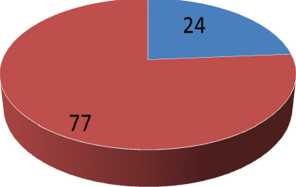
-
■ краниоцервикальные
-
■ субаксиальные
Рис. 1. Диаграмма: структура повреждений шейного отдела позвоночника (ШОП) (n = 101)
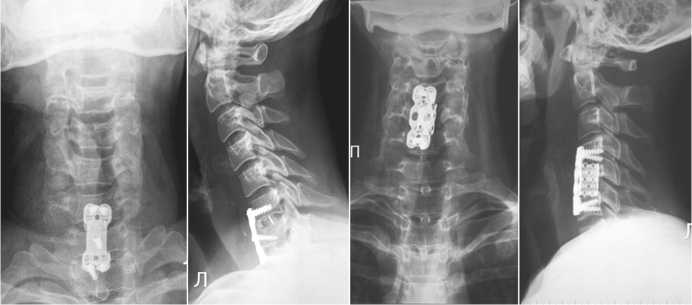
Рис. 2. Рентгенограммы шейного отдела позвоночника с использованием вариантов передней фиксации

Рис. 3. Рентгенограммы и МСКТ ШОП после различных вариантов задней фиксации винтовыми конструкциями
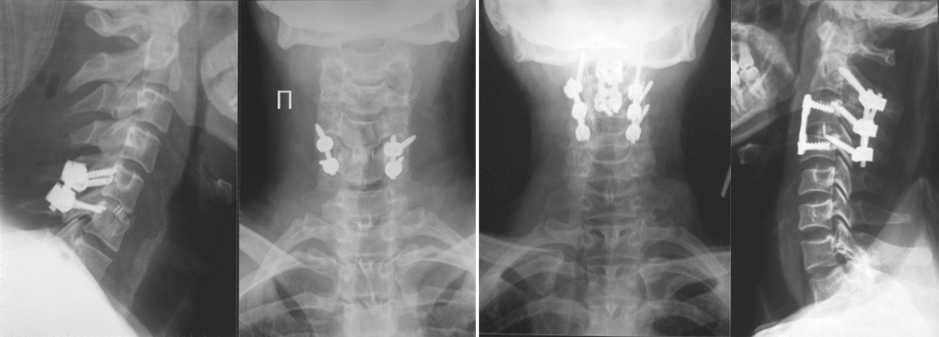
Рис. 4. Рентгенограммы ШОП после фиксации на 360° (передней и задней)



субаксиальный отдел п=45





субаксиальный отдел п=22
краниоцервикальный отдел п=24
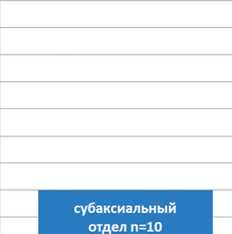
комбинированная (на 360°) фиксация
передняя фиксация
задняя фиксация
Рис. 5. Диаграмма: распределение методик фиксации при повреждениях ШОП (n = 101)
РЕЗУЛЬТАТЫ
Согласно проведенному литературному анализу, для оценки повреждений наиболее часто используются следующие классификации: Anderson&Montesano для оценки атланто-окципитального сегмента (С0–СI) (3 типа) [1, 2, 4]; L.D. Anderson&D’Alonso – для оценки повреждений зуба С2 позвонка (3 типа) [1, 2], при этом повреждения 2-го типа в зависимости от направления линии перелома дополнительно разделялись на 3 подтипа: А – передний косой, В – задний косой, С – горизонтальный [1, 2, 4, 7];
Для субаксиального отдела (С3–С7) предложено большое количество морфологических систем классификаций. Однако в последнее время наиболее используемыми являются балльные системы SLIC [11–13] и CSISS [14]. «Критическими» следует считать следующие типы повреждений: вывихи и переломовывихи позвонков; переломы боковых масс с формированием подвывиха; переломы тел позвонков (с или без разры- вов межпозвонковых дисков) в сочетании с повреждениями задних структур (в том числе связочных) [1–3, 5–8, 15–17]. При этом сумма баллов по классификациям SLIC и CSISS равна или превышает 4 и 7 соответственно [2, 3, 7, 11–14].
В нашей группе среди пациентов с краниоцервикальными повреждениями (24 человека) у 14 диагностирован перелом «палача» и разнообразные переломы С2 (miscellaneous axis fractures), у 8 перелом зуба С2 II и III типов, двое пациентов имели разрыв поперечной связки атланта. Во всех случаях выполнялась задняя фиксация с применением полиаксиальных винтов. При разрыве поперечной связки атланта – окципитоспондилодез или фиксация по Harms; переломы зуба С2 позвонка стабилизировались по Harms или Magerl (рис. 3).
При субаксиальных повреждениях использовались различные варианты передней (у 45 пациентов), задней (у 22 пациентов) и комбинированной (у 10 пациентов) фиксации.
При этом все повреждения заднего опорного комплекса (связочного аппарата и боковых масс) стабилизировались с использованием задней фиксации (рис. 3). При всех многоколонных повреждениях использовалась комбинированная (на 360°) стабилизация (рис. 4). Передняя фиксация выполнялась как при изолированных разрушениях передней колонны, с формированием передней компрессии нервных структур, так и при наличии «не критических» повреждений заднего опорного комплекса (дуги, остистого отростка) (рис. 2).
ОБСУЖДЕНИЕ
В структуре повреждений шейного отдела позвоночника преобладают субаксиальные повреждения, распространенность которых достигает 75 % от всей травмы ШОП [1–3, 6–8, 15, 17]. Доля атланто-окципитальной дислокации не превышает 1 % всех повреждений ШОП [1, 2, 4, 18]. В 90 % случаев этот вид травмы является фатальным [1, 2, 4]. Переломы мыщелков затылочной кости и атланта являются достаточно редкими [1, 2, 4, 7]. По литературным данным, они не превышают 0,4 % всех повреждений [4, 19, 20]. На долю переломов С1 позвонка приходится от 2 до 13 % всех переломов ШОП [4, 8, 21, 22]. Проведенный ретроспективный анализ лечения 101 пациента и данные литературы свидетельствуют, что среди краниоцервикальной травмы преобладают повреждения С2 позвонка. Переломы зуба составляют 50–60 % всех повреждений С2 позвонка [4, 23], при этом 37–83 % приходится на тип II [4, 7, 23, 24]. Переломы «палача» составляют около 20 % всех повреждений С2 [4, 10]. На долю других (разных) переломов С2 приходится 19–32 % всех его повреждений [4, 7]. Следует отметить, что для переломов С2 позвонка предложено большое количество классификаций в зависимости от локализации повреждений (зубовидный отросток, ножки позвонка). При этом существует отдельная группа повреждений С2, названных «miscellaneous axis fractures» (различные переломы аксиса), которые систематизировать не представляется возможным. Эти обстоятельства свидетельствуют о том, что переломы С2 позвонка являются самыми сложными среди всех повреждений шейного отдела позвоночника.
Выбор метода лечения при повреждениях зубовидного отростка С2 позвонка (II и III типов) наиболее противоречив (особенно у пожилых) [23–27]. Консервативное лечение несет высокий риск несращения [23, 24], а оперативное лечение изначально может казаться недостаточно оправданным [4]. В последнее время все большее распространение при переломах зуба С2 получает фиксация винтом из переднего доступа [1, 2, 4]. Однако методика имеет ряд существенных ограничений: невозможность использования при мелкооскольчатых переломах, ограниченные репозиционные возможности, тучные пациенты с короткой шеей, бочкообразная грудная клетка, выраженный грудной кифоз, давность травмы более 6 месяцев, возраст старше 50 лет [1–4, 7, 28]. При этом консолидация отмечается в 80,5 % случаев. По данным литературы, риск несрасщения отломков в 37,5 раза увеличивается при отсрочке лечения более чем на одну неделю и в 21 раз, если диастаз между костными фрагментами превышает 2 мм [1–3, 7, 8, 28]. В связи с этим задняя фиксация C1–C2 по Harms и Magerl остаются методами выбора, когда невозможна передняя фиксация или консервативное лечение потерпело неудачу [2–5, 7, 28–30].
Кроме того, эти методики предпочтительны при повреждениях зуба С2 с формированием атланто-аксиальной дислокации (ААД) [29, 30, 31]. Однако некоторые авторы рекомендуют применять переднюю трансоральную редукцию и фиксацию [4].
Тактика лечения при переломах «палача» также остается спорной [1, 2, 4, 6, 7, 15]. Повреждения II, IIa, III типов требуют оперативного лечения, из которого наиболее распространенными являются 4 способа стабилизации: передняя фиксация С2–С3, задняя фиксация С2–С3 винтами, комбинированная фиксация на 360°, прямая фиксация С2 двумя винтами [1–7, 10, 15, 32, 33]. Передняя фиксация С2–С3 так же как и прямая фиксация С2 двумя винтами не обеспечивает должной стабилизации поврежденных задних структур, в связи чем необходимо применение внешней иммобилизации [2, 4, 9, 34]. Наиболее надежными методами лечения переломов II, IIa, III типов являются задняя фиксация С2–С3 или стабилизация на 360° [9, 10, 34].
Что касается «miscellaneous axis fractures», тактика зависит от локализации повреждений. Так, переломы тела нуждаются в оперативной стабилизации, тогда как изолированные переломы дуги или остистых отростков могут лечиться консервативно [4, 7].
Для оценки субаксиальных повреждений до сих пор используются морфологические классификации. Однако все они были разработаны без учета диагностических возможностей МСКТ и МРТ [7, 12, 13]. Вследствие чего они не в полной мере учитывают характер повреждений. Кроме того, при использовании данных классификаций высоким остается процент как внутри-, так и межэкспертного расхождения, что вносит путаницу между специалистами. Также данные классификации не предусматривают выбор тактического алгоритма, что делает их применение бессмысленным [7, 35]. Большое значение при планировании лечения следует уделять оценке повреждений заднего опорного комплекса, на который приходится около 64 % всей опорной нагрузки [1, 2, 7]. В настоящее время наиболее используемыми классификациями являются балльные: SLIC и CSISS [2, 12, 13].
Среди методик лечения нестабильных субаксиальных повреждений наиболее распространенной остается передняя фиксация [3, 6, 7, 35–37]. В ряде случаев она является единственным способом стабилизации даже при многоколонных повреждениях (вывихах, переломовывихах, травматических спондилолистезах), что существенно увеличивает риск несостоятельности фиксации [38–43]. В последнее время все большее распространение получает задняя винтовая фиксация, особенно при травме заднего опорного комплекса [44–47]. При многоколонных повреждениях, по мнению ряда авторов, требуется фиксации на 360° [12, 16, 48].
ЗАКЛЮЧЕНИЕ
-
• Cреди краниоцервикальных повреждений преобладают переломы на уровне С2 позвонка, при этом их оценка является наиболее сложной.
-
• Субаксиальные повреждения требуют особенно тщательной оценки целостности заднего опорного комплекса. Их оценка с использованием балльных классификаций (SLIC и CSISS) является наиболее оправданной с точки зрения определения тактики лечения.
-
• При нестабильных краниоцервикальных повреждениях методом выбора является задняя винтовая фиксация по Magerl или Harms.
-
• При субаксиальной травме наибольшее распространение получили различные варианты передней фиксации.
-
• Многоколонные субаксиальные повреждения в большинстве случаев требуют задней фиксации или стабилизации на 360°.
Список литературы Выбор метода стабилизации при травмах шейного отдела позвоночника
- Cervical Spine. 4th Edition/Eds. C.R Clark, E.C. Benzel, B.L Currier, J.P. Dormans, J.E. Dvorak, S.R. Garfin, H.N. Herkowitz, C.G. Ullrich, A.R. Vaccaro. Lippincott: Williams & Wilkins, 2005. 1222 pp.
- Cervical Spine. 5th Edition/Eds. A.R. Vaccaro, J.J. Regan, A.H. Crawford, E.C. Benzel, D.G. Anderson. Lippincott: Williams & Wilkins, 2012. 1594 pp.
- Patel V.V., Burger E., Brown C.W. Spine Trauma, Surgical Techniques. 1st edition/Eds. V.V. Patel, E. Burger, C.W. Brown. Berlin-Heidelberg: Springer, 2010. 413 pp.
- Suchomel P., Choutka O. Reconstruction of Upper Cervical Spine and Craniovertebral Junction. Springer, 2011. 322 pp.
- Boos N., Aebi M. Spinal Disorders: Fundamentals of Diagnosis and Treatment. Springer, 2008. 1166 pp
- Adult and Pediatric Spine. The, 3rd Edition/Eds. J.W. Frymoyer, S.W. Wiesel, H.S. An, S.D. Boden, W.C. Lauerman, L.G. Lenke, R.F. McLain. Lippincott: Williams & Wilkins Copyright, 2004. 1236 pp.
- Herkowitz H.N. The Spine. 6th Edition. Elsevier Saunders. 2011. 2020 pp.
- Fractures of the cervical, thoracic and lumbar spine/Ed. A.R. Vaccaro. New York: Marcel Dekker, 2003. 751 pp.
- Liu J., Li Y., Wu Y. One stage posterior C2 and C3 pedicle screw fixation or combined anterior C2 C3 fusion for the treatment of unstable hangman's fracture//Exp. Ther. Med. 2013. Vol. 5, N 3. P. 667-672.
- Posterior fixation and fusion of unstable Hangman’s fracture by using intraoperative three-dimensional fluoroscopy-based navigation/W. Tian, C. Weng, B. Liu, Q. Li, L. Hu, Z.Y. Li, Y.J. Liu, Y.Z. Sun//Eur. Spine J. 2012. Vol. 21, N 5. P. 863-871.
- Classification and surgical decision making in acute subaxial cervical Spine trauma/A.A. Patel, R.J. Hurlbert, C.M. Bono, J.T. Bessey, N. Yang, A.R. Vaccaro//Spine. 2010. Vol. 35. N 21 Suppl. P. S228-S234.
- The subaxial cervical Spine injury classification system: a novel approach to recognize the importance of morphology, neurology, and integrity of the disco-ligamentous complex/A.R. Vaccaro, R.J. Hulbert, A.A. Patel, C. Fisher, M. Dvorak, R.A. Lehman Jr., P. Anderson, J. Harrop, F.C. Oner, P. Arnold, M. Fehlings, R. Hedlund, I. Madrazo, G. Rechtine, B. Aarabi, M. Shainline; Spine Trauma Study Group//Spine. 2007. Vol. 32, N 21. P. 2365-2374.
- The surgical approach to subaxial cervical Spine injuries: an evidence-based algorithm based on the SLIC classification system/M.F. Dvorak, C.G. Fisher, M.G. Fehlings, Y.R. Rampersaud, F.C. Oner, B. Aarabi, A.R. Vaccaro//Spine. 2007. Vol. 32, N 23. Р. 2620-2629.
- Cervical spine injury severity score. Assessment of reliability/P.A. Anderson, T.A. Moore, K.W. Davis, R.W. Molinari, D.K. Resnick, A.R. Vaccaro, C.M. Bono, J.R. Dimar 2nd, B. Aarabi, G. Leverson; Spinal Trauma Study Group//J. Bone Joint Surg. Am. 2007. Vol. 89, N 5. Р.1057-1065.
- Holtz A., Levi R. Spinal cord injury. Oxford University Press, 2010. 319 pp.
- Song K.J., Park H., Lee K.B. Treatment of irreducible bilateral cervical facet fracture-dislocation with a prolapsed disc using a prefixed polyetheretherketone cage and plate system//Asian Spine J. 2013. Vol. 7, N 2. P. 111-114.
- Surgical Management of Spinal Cord Injury/Ed. A.P. Amar. Blacwell Futura, 2007. 256 pp.
- Traumatic atlanto-occipital dislocation with atlantoaxial subluxation/S. Hamai, K. Harimaya, T. Maeda, A. Hosokawa, J. Shida, Y. Iwamoto//Spine. 2006. Vol. 31, N 13. P. E421-E424.
- Nonoperative treatment of occipital condyle fractures: an outcomes review of 32 fractures/J.J. Maddox, J.A. Rodriguez-Feo 3rd, G.E. Maddox, G. Gullung, G. McGwin, S.M. Theiss//Spine. 2012. Vol. 37, N. 16. P. E964-E968.
- Occipital condyle fractures. Prospective follow-up of 31 cases within 5 years at a level 1 trauma centre/F.J. Mueller, B. Fuechtmeier, B. Kinner, M. Rosskopf, C. Neumann, M. Nerlich, C. Englert//Eur. Spine J. 2012. Vol. 21, N 2. P. 289-294.
- A biomechanical rationale for C1-ring osteosynthesis as treatment for displaced Jefferson burst fractures with incompetency of the transverse atlantal ligament/H. Koller, H. Resch, M. Tauber, J. Zenner, P. Augat, R. Penzkofer, F. Acosta, K. Kolb, A. Kathrein, W. Hitzl//Eur. Spine J. 2010. Vol. 19, N 8. P. 1288-1298.
- Posterior osteosynthesis of the atlas for nonconsolidated Jefferson fractures: a new surgical technique/L. Abeloos, O. De Witte, M. Walsdorff, I. Delpierre, M. Bruneau//Spine. 2011. Vol. 36, N 20. P. E1360-E1363.
- Conservative treatment in patients with Type 2 odontoid fracture -functional outcome following Halovest immobilization/A. Zairul, A. Vicknesh, A. Zulkefli, R. Ramanathan//Malaysian Orthop. J. 2010. Vol. 4, N 2. P. 13-16.
- Effect of type II odontoid fracture nonunion on outcome among elderly patients treated without surgery: based on the AOSpine North America geriatric odontoid fracture study/J.S. Smith, C.K. Kepler, B. Kopjar, J.S. Harrop, P. Arnold, J.R. Chapman, M.G. Fehlings, A.R. Vaccaro, C.I. Shaffrey//Spine. 2013. Vol. 38, N. 26. P. 2240-2246.
- Pal D., Sell P., Grevitt M. Type II odontoid fractures in the elderly: an evidence-based narrative review of management//Eur. Spine J. 2011. Vol. 20, N 2. P. 195-204.
- Predictors of treatment outcomes in geriatric patients with odontoid fractures: AOSpine North America multi-centre prospective GOF study/M.G. Fehlings, R. Arun, A.R. Vaccaro, P.M. Arnold, J.R. Chapman, B. Kopjar//Spine. 2013. Vol. 38, N 11. P. 881-886.
- The long-term functional outcome of type II odontoid fractures managed non-operatively/J.S. Butler, R.T. Dolan, M. Burbridge, C.J. Hurson, J.M. O’Byrne, D. McCormack, K. Synnott, A.R. Poynton//Eur. Spine J. 2010. Vol. 19, N 10. P. 1635-1642.
- Cho D.C., Sung J.K. Analysis of risk factors associated with fusion failure after anterior odontoid screw fixation//Spine. 2012. Vol. 37, N 1. P. 30-34.
- Goel A., Desai K.I., Muzumdar D.P. Atlantoaxial fixation using plate and screw method: a report of 160 treated patients//Neurosurgery. 2002. Vol. 51, N 6. P. 1351-1357.
- Safety issues and neurological improvement following C1-C2 fusion using C1 lateral mass and C2 pedicle screw in atlantoaxial instability/M.K. Kwan, C.Y.W. Chan, T.C.C. Kwan, Y.N. Gashi, L.B. Saw//Malaysian Orthop. J. 2010. Vol. 4, N 2. P. 17-22.
- Maida G., Marcati E., Sarubbo S. Posttraumatic atlantoaxial rotatory dislocation in a healthy adult patient: a case report and review of the literature//Case Rep. Orthop. 2012. Vol. 2012. 183581 DOI: 10.1155/2012/183581
- ElMiligui Y., Koptan W., Emran I. Transpedicular screw fixation for type II Hangman’s fracture: a motion preserving procedure//Eur. Spine J. 2010. Vol. 19, N 8. P. 1299-1305.
- Patibandla M.R., Mudumba V., Yerramneni V.K. Double Hangman’s Fracture//Spine. 2013. Vol. 38, N 6. P. E374-E377.
- Posterior short-segment fixation and fusion in unstable Hangman‘s fractures/W. Ma, R. Xu, J. Liu, S. Sun, L. Zhao, Y. Hu, W. Jiang, G. Liu, Y. Gu//Spine. 2011. Vol. 36, N 7, P. 529-533.
- What should an ideal spinal injury classification system consist of? A methodological review and conceptual proposal for future classifications/J.J. van Middendorp, L. Audigé, B. Hanson, J.R. Chapman, A.J. Hosman//Eur. Spine J. 2010. Vol. 19, N 8. P. 1238-1249.
- Kim K.H., Cho D.C., Sung J.K. The management of bilateral interfacetal dislocation with anterior fixation in cervical spine: comparison with combined antero-posterior fixation//J. Korean Neurosurg. Soc. 2007. Vol. 42, N 4. P. 305-310.
- Mid-to long-term outcome of instrumented anterior cervical fusion for subaxial injuries/H. Koller, J. Reynolds, J. Zenner, R. Forstner, A. Hempfing, I. Maislinger, K. Kolb, M. Tauber, H. Resch, M. Mayer, W. Hitzl//Eur. Spine J. 2009. Vol. 18, N 5. P. 630-653.
- C3-C4 spondyloptosis without neurological deficit -a case report/S.K. Srivastava, K.M. Agrawal, A.K. Sharma, M.D. Agrawal, S.K. Bhosale, S.R. Renganathan//Spine J. 2010. Vol. 10, N 7. P. e16-e20.
- Fracture and contralateral dislocation of the twin facet joints of the lower cervical spine/L.M. Ngo, T. Aizawa, T. Hoshikawa, Y. Tanaka, T. Sato, Y. Ishii, S. Kokubun//Eur. Spine J. 2012. Vol. 21, N 2. P. 282-288.
- Gasco J., Dilorenzo D.J., Patterson J.T. C4-C5 post-traumatic spondyloptosis with in situ fusion: systematic literature review and case report//Spine. 2013. Vol. 38, N 10. P. E621-E625.
- Kim H.J., Lee K.Y., Kim W.C. Treatment outcome of cervical tear drop fracture//Asian Spine J. 2009. Vol. 3, N 2. P. 73-79.
- Management of fracture-dislocation of the lower cervical spine with the cervical pedicle screw system/F. Zhou, J. Zou, M. Gan, R. Zhu, H. Yang//Ann. R. Coll. Surg. Engl. 2010. Vol. 92, N 5. P. 406-410.
- Misdiagnosed bilateral C5-C6 dislocation causing cervical spine instability: a case report/I.D. Gelalis, G. Christoforou, C.M. Arnaoutoglou, A.N. Politis, G. Manoudis, T.A. Xenakis//Cases J. 2009. Vol. 2. P. 6149.
- Posterior cervical fixation with nitinol shape memory loop in the anterior-posterior combined approach for the patients with three column injury of the cervical spine: preliminary report/D.K. Yu, D.H. Heo, S.M. Cho, J.H. Choi, S.H. Sheen, Y.J. Cho//J. Korean Neurosurg. Soc. 2008. Vol. 44, N 5. P. 303-307.
- Spine surgery in neurological lesions of the cervicothoracic junction: multicentric experience on 33 consecutive cases/A. Ramieri, M. Domenicucci, P. Ciappetta, P. Cellocco, A. Raco, G. Costanzo//Eur. Spine J. 2011. Vol. 20, Suppl. 1. P. S13-S19.
- Stage 4 compressive-extension injury of the cervical Spine: a theoretical stage?/K.S. Suk, K.T. Kim, J.H. Lee, S.H. Lee, J.S. Kim, J.H. Eoh//Spine. 2010. Vol. 35, N 15. P. E733-E738.
- Unilateral facet dislocations: Is surgery really the preferred option?/M. Dvorak, A.R Vaccaro, J. Hermsmeyer, D.C. Norvell//Evid. Based Spine Care J. 2010. Vol. 1, N 1. P. 57-65.
- Signoret F., Jacquot F.P., Feron J.M. Reducing the cervical flexion tear-drop fracture with a posterior approach and plating technique: an original method//Eur. Spine J. 1999. Vol. 8, N 2. P. 110-116.

